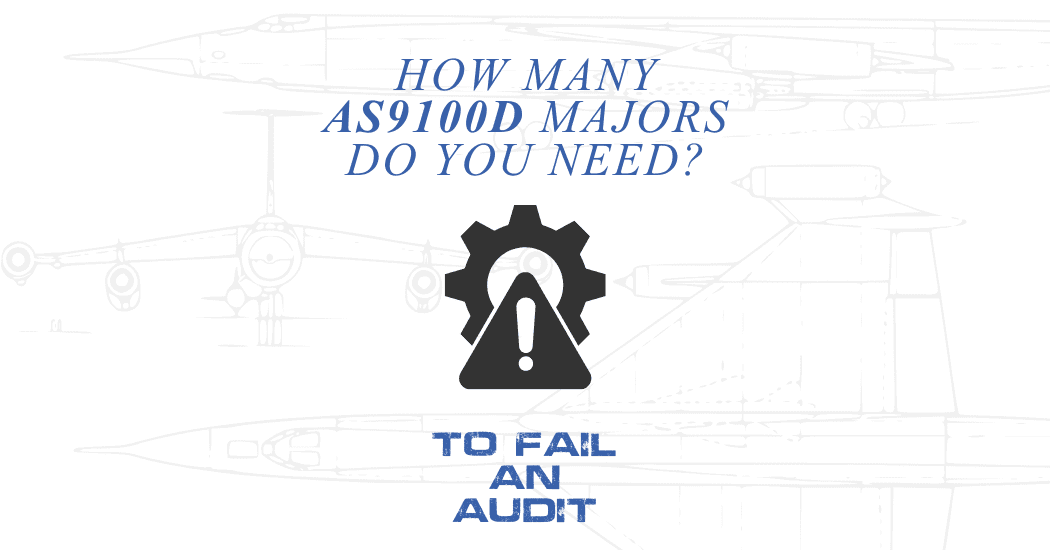Short answer:
A single major nonconformity (Major NC) can cause an AS9100 audit to fail or be suspended until it is corrected.
Certification bodies treat any major nonconformity as a significant breakdown in the Quality Management System (QMS). Unlike minor nonconformities—which can often be corrected with standard corrective actions—majors demonstrate systemic, structural, or high-risk issues that prevent the auditor from granting or maintaining certification.
Understanding Major vs. Minor Nonconformities
Major Nonconformity
A major NC indicates one of the following:
- The QMS does not meet a required clause of AS9100
- There is evidence of a system-wide breakdown
- There is no effective implementation of a required process
- The issue impacts the organization’s ability to consistently deliver conforming products or services
- The issue poses audit, safety, regulatory, or customer risk
Minor Nonconformity
A minor NC indicates:
- A lapse in following a documented process
- An isolated issue that does not indicate system failure
- A weakness or inconsistency, but not a systemic gap
How Many Majors Cause an AS9100 Audit Failure?
1 Major = Audit Failure or Suspension Until Corrected
Certification auditors treat a single major NC as grounds to:
- Halt certification
- Require corrective action
- Schedule a follow-up (special) audit
- Delay issuance of the certificate
The organization must:
- Perform root-cause analysis
- Implement corrective actions
- Provide evidence of full containment
- Pass a follow-up assessment
Only then will certification move forward.
Multiple Majors = Escalated Risk and Longer Recovery Timeline
While one major is enough to fail, auditors typically view multiple majors as:
- A sign of a severely weak or ineffective QMS
- A risk to customers
- A potential indicator of noncompliance with regulatory or contract requirements
- Grounds for extended suspension or full withdrawal of certification
In practice:
- 1 major = fail until corrected
- 2–3 majors = deeper system review and increased verification
- 4+ majors = certification body may recommend withdrawal or full recertification
Examples of Documentation-Related Majors
Documentation issues often cause majors when they show evidence of systemic breakdown. Examples include:
- No documented procedure for a required clause
- Documented process exists but is not being followed
- Missing or uncontrolled versions of procedures
- Incomplete or incorrect records for key processes
- No evidence of document control, review, or approval
- Critical forms or logs not maintained or traceable
- Inconsistent revision control across the QMS
These issues affect:
- Traceability
- Risk management
- Product conformity
- Audit readiness
- Supplier oversight
- Production and inspection quality
Why a Single Major Is Treated So Seriously
A major NC means:
- The QMS cannot be trusted to produce consistent results
- A required clause is not implemented
- A process essential to safety, quality, or regulatory expectations is compromised
For aerospace suppliers, this is critical due to:
- High product risk
- Industry traceability requirements
- Contract compliance expectations
- Chain-of-custody and counterfeit-prevention concerns
- Safety and reliability of flight-critical components
How to Avoid Major Nonconformities
1. Maintain strong document control
Ensure every procedure, work instruction, and form is:
- Current
- Approved
- Controlled
- Accessible
- Used consistently
2. Conduct robust internal audits
Internal audits should:
- Be risk-based
- Cover every clause
- Identify gaps before external audits
- Include evidence-based findings
3. Maintain complete records
Logs, forms, and reports must show:
- Traceability
- Revision history
- Correct usage
- Alignment with what the procedure says
4. Perform management reviews
Regular reviews demonstrate QMS oversight and ensure:
- Risks are tracked
- Objectives are monitored
- Corrective actions close properly
When a Major Occurs: What Happens Next?
To regain audit compliance:
- Contain the issue
- Perform root-cause analysis (5-Why, fishbone, etc.)
- Develop a corrective action plan
- Implement the fix across the system
- Provide evidence to the auditor
- Undergo a follow-up audit
Only after this will certification be resumed or granted.

Ronnie Lee Roberts II has worked in the Department of Defense (DoD) quality environment since 2017, supporting programs at Patuxent River and Webster Field (NAWCAD/NAVAIR). A certified AS9100:2016 Rev D Lead Auditor (2022–2025), he brings deep knowledge of quality management systems, documentation control, and audit readiness across aerospace and defense operations. His background includes hands-on experience inspecting to specification per engineering drawings and customer requirements, verifying process conformity, and maintaining compliance with AS9100D clauses related to documented information, product realization, and risk management.
In addition to audit work, Ronnie has supported QMS development, technical writing, CAD-based documentation, and controlled record structures that ensure traceability and repeatability. He also holds ISO/IEC 20000-1:2018 Lead Auditor (TPECS, 2023) and Certified CMMI® Associate (2025) credentials, supporting CMMI-DEV Level 3 environments. His focus remains on aligning documentation and inspection practices with AS9100D standards to drive measurable quality performance and readiness for customer and regulatory audits.

